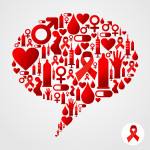 It’s now recommended that everyone 13 years old and over get HIV testing as part of routine check-ups every year. If you are sexually active or sharing needles, testing is recommended every 3-6 months or with a new partner. Not everyone who is infected with HIV has symptoms or feels sick, so getting tested and knowing your status is the only way to know for sure that you’re negative. It’s also important to get tested on a regular basis, because when HIV is found early, a person can start treatment right away before the virus has done too much damage.
It’s now recommended that everyone 13 years old and over get HIV testing as part of routine check-ups every year. If you are sexually active or sharing needles, testing is recommended every 3-6 months or with a new partner. Not everyone who is infected with HIV has symptoms or feels sick, so getting tested and knowing your status is the only way to know for sure that you’re negative. It’s also important to get tested on a regular basis, because when HIV is found early, a person can start treatment right away before the virus has done too much damage.
The number of new infections in young people makes it very important that everybody gets a test and gets a repeat test if involved in any risky behaviors. Deciding to get tested can be the hardest part, so give yourself credit for taking a big step to get tested.
What is a test like?
There are many places to get HIV tests, such as your primary care provider’s office or a special testing site. You’ll first receive information about HIV, risk factors for HIV, and the types of different tests. You will have time to ask questions and talk about any concerns about getting tested. It’s your choice to get a test.
The second part is getting the test.
There are three main tests:
- Combination/Fourth-Generation: The fourth-generation test, which is a type of blood test which takes about 7-10 days to get the results. This test is sensitive enough to detect HIV in your blood 2 weeks after a possible exposure. Offered almost everywhere.
- Rapid test (finger stick and oral tests): Both tests take about 20 minutes to get the results. This test will provide you with results 6 to 8 weeks after an exposure.
1. Blood test is a finger stick; a small amount of blood is taken from the tip of the finger and mixed in a solution.
2. Oral test – a small amount of saliva from a person’s mouth is obtained using a cotton swab that looks like a toothbrush. - NATs: NATs detect HIV the fastest by looking for HIV in the blood. It can take 7 to 28 days for NATs to detect HIV. This test is very expensive and is not routinely used for HIV screening unless the person recently had a high-risk exposure or a possible exposure with early symptoms of HIV infections. This test is not as readily available (often done by a lab if the fourth-generation test comes back reactive).
If either rapid test is positive, the fourth-generation test is done (on a blood test) to confirm that the person is HIV positive.
It’s important to know there are three types of results that can come from a rapid test: non-reactive, invalid, and reactive.
- A non-reactive result means that no HIV antibodies were found. This would find any exposures which happened 6 weeks prior to test or before that. A non-reactive test does not mean that a person is immune to HIV in the future, only that they do not show the virus in their body at the time of the test.
- An invalid result means that the test did not work properly and it will have to be repeated.
- A reactive result is considered a preliminary positive, and means that HIV antibodies were found. A second test needs to be done using blood drawn once from the arm, to confirm the first test’s result.
There is another test available for home use:
- The Home Access Kit®: This test has been approved by the Food Drug Administration (FDA). You can buy it at most pharmacies without a prescription. This is also a “finger stick” blood test. You prick your finger and place a drop of blood on a card that comes with the kit. You send the card to a lab and you can then get the results by phone in 1-3 days.
No matter which test a person chooses to do, it’s very important to always get your results.
The third and last part of testing is getting your results and talking about what those results mean for the future.
Almost all testing sites in the state of Massachusetts offer confidential testing. A “confidential test” uses your name and some other identifying information. All that information is locked. Only the testing provider is able to see that result and only with your approval will the tester be able to share this result with your primary care provider if you so choose.
Anonymous testing doesn’t use your name. It uses code names or numbers in order to identify your test and results.
Different test sites as well as different states have their own rules. Find out if the test is free, and who will have access to the results before you go to get tested.
Where Can I Get Tested?
You can get tested at your primary care provider’s office or at a local testing center. If you live in the US, find a local testing center near you on the CDC HIV testing resource site. This site has a feature where you can type in your zip code, and get the names and addresses of testing locations near you. It’s sponsored by the Centers for Disease Control and Prevention (CDC).
Source: Read Full Article